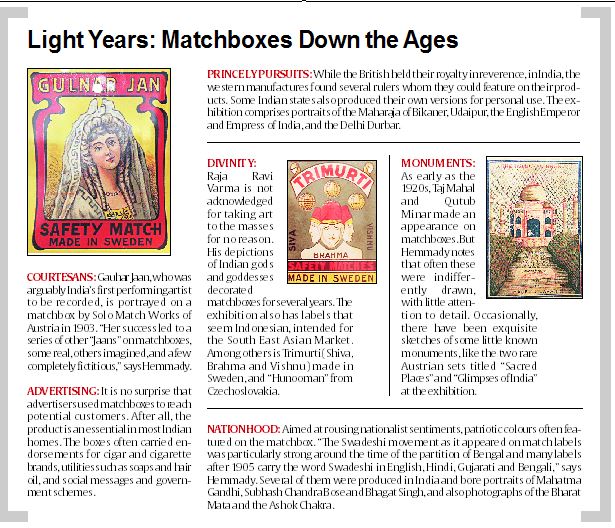India Meets its Match
An exhibition on matchboxes chronicles the journey of a nation.
 Gautam Hemmady with his matchbox collection in Delhi Photos:
Gautam Hemmady with his matchbox collection in Delhi Photos:
From nationalism to deities to Bollywood, the labels on the matchboxes on display capture both the changing and the abiding preoccupations of India. “I wanted to understand the evolution and history of matchboxes. The manufacturers have constantly searched for something people could relate with. There were thousands of brands that came and went, yet few stayed on. When you see them all together, it looks like a riot of visuals and popular culture,” says Delhi-based phillumenist Gautam Hemmady.
Over the last four years, the 55-year-old has collected over 25,000 matchboxes, matchbox labels, catalogues and published articles, some of which comprise the ongoing exhibition titled “Matchbox labels and The Stories They Tell” at the India International Centre in Delhi.

Hemmady had always been interested in matchboxes but it was on a nippy January morning when he, out on his morning walk, made the first purchase for his collection. “There is no documentation of matchboxes in India. Often, I have to look for hints in the pictures to estimate their period. For instance, sometimes with Indian labels, the price is an indicator — six or seven paisa would be the late 1960s; the old currency, six pies or nine pies would be before 1957; unpriced labels would be before 1950,” says Hemmady. He recalls his walk that day, when he returned with six-eight matchboxes. Some of these, he was to barter with other phillumenists in the coming years, others became part of his collection.
While he browses the old bazaars of Delhi and Mumbai to add to his collection, Hemmady also regularly checks websites trading in memorabilia and writes to phillumenists the world over. “We share notes and trade with each other. We part with duplicates, or barter other goods for matchboxes, sometimes there is money involved,” says Hemmady, a trained architect. It was from a fellow collector that he acquired a matchbox manufactured in Bengal in the 1890s, the oldest in his collection. Another set of rare boxes he owns is a limited edition zodiac signs series produced by Wimco.
India has numerous matchbox manufacturers today but Hemmady notes that till the 1940s, the market was flooded with imported products from Japan, Czechoslovakia, Austria and Sweden. “They were the suppliers of matchboxes when the Indian industry could not even cater to 10 per cent of the demand, before World War I.” In fact, the country of origin also helps determine its period. “Right in beginning, sometimes they sent Norwegian matchboxes. The Austrian ones invariably are before World War I, Czechoslovakia means after the war, because that’s when it was formed. Sweden could be anything till 1947, because that’s when imports were banned,” he says.
Once India set up its own units, the faces on the boxes altered and the attention given to its design gradually dwindled, feels Hemmady. “People figured quality matters more than the artwork on the box. Today, in India, there are thousands of brands.” They did not completely ignore the picture though — for this is when Bollywood stars became prominent as did more contemporary patterns. But Hemmady wishes there was more documentation of these little boxes that hold within them the journey of a nation.





- 01
- 02
- 03
- 04
- 05






















